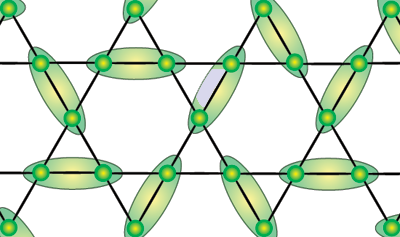Identifying Traits of Quantum Spin Liquids: A Three-Pronged Strategy

November 16, 2023
Reviewed following the editorial process and policies of Science X, this article highlights the following attributes to ensure the content's credibility:
- fact-checked
- peer-reviewed publication
- trusted source
- proofread
by Elizabeth Rosenthal, Oak Ridge National Laboratory
Physicist Phil Anderson proposed the existence of the quantum spin liquid (QSL) state on some triangular lattices back in 1973, but was unable to probe further due to technological limitations. After five decades, researchers affiliated with the Quantum Science Center, based out of the Oak Ridge National Laboratory under the Department of Energy, have authenticated the existence of QSL behavior in a new triangular lattice material, namely KYbSe2.
QSLs—an uncommon state of matter governed by intertwined magnetic atoms known as spins—display notable proficiency at stabilizing quantum mechanical activity in KYbSe2 and other delafossites thereby making them valuable for their layered triangular lattices and prospective properties which could assist in the creation of high-performance superconductors and quantum computing parts.
The study, made public in Nature Physics, includes researchers from ORNL; Lawrence Berkeley National Laboratory; Los Alamos National Laboratory; SLAC National Accelerator Laboratory; the University of Tennessee, Knoxville; the University of Missouri; the University of Minnesota; Stanford University; and the Rosario Physics Institute.
'The triangular lattice of various materials has been studied extensively for QSL behavior,' says QSC member and main author, Allen Scheie, a Los Alamos staff scientist. 'The benefit of this lattice structure is that we can easily replace atoms to change the material's behavior without tampering with its structure. This makes it an ideal specimen from a scientific point of view.'
The research team used a mix of theoretical, experimental and computational methods to observe multiple QSL signatures: quantum entanglement, unusual quasiparticles, and the right balance of exchange interactions which govern how a spin affects its immediate neighbors. Although previous attempts have been hampered by the constraints of physical experiments, modern neutron scattering devices can now yield precise measurements of such complex materials at an atomic level.
KYbSe2's spin dynamics were studied with the Cold Neutron Chopper Spectrometer at ORNL's Spallation Neutron Source—a DOE Office of Science user facility—to determine the material was nearing the quantum critical point favoring QSL characteristics. Its single-ion magnetic state was then inspected with SNS's Wide-Angular-Range Chopper Spectrometer.
The primary markers used were the one-tangle, two-tangle and quantum Fisher information, central in previous QSC research studying a 1D spin chain within a material. However, as KYbSe2 is a 2D system, the complexity of the tasks increased.
'We are incorporating a co-design approach deeply ingrained in the QSC,' says Alan Tennant, a professor of physics and materials science and engineering at UTK who is leading a quantum magnets project for the QSC. 'In-house theorists are calculating aspects previously deemed unachievable, and this synergy between theory and experiment facilitated this QSL research breakthrough.'
The study aligns with the QSC's priorities which encompass bridging fundamental research to quantum electronics, quantum magnets and other quantum devices currently in use or under development.
'A deeper understanding of QSLs is crucial for the evolution of next-gen technologies,' Tennant states. 'Although we're still in the stage of fundamental research, we're now capable of identifying which materials can be altered to potentially create small-scale devices from the ground up.'
Although KYbSe2 doesn't entirely exhibit QSL characteristics, about 85% of the magnetism fluctuates at low temperature, indicating high potential to become a full-fledged QSL. Researchers believe slight modifications to its structure or exposure to external pressure could help it achieve 100% QSL characteristics.
QSC experimentalists and computational scientists are planning parallel studies and simulations on delafossite materials. The researchers' findings have set an unmatched protocol that can be applied to study other systems as well. Their aim is to expedite the hunt for authentic QSLs by streamlining evidence-based assessments of potential QSL candidates.
'The important thing about this material is that we've found a way to orient ourselves on the map so to speak and show what we've gotten right,' Scheie said. 'We're pretty sure there's a full QSL somewhere within this chemical space, and now we know how to find it.'
Journal information: Nature Physics
Provided by Oak Ridge National Laboratory




